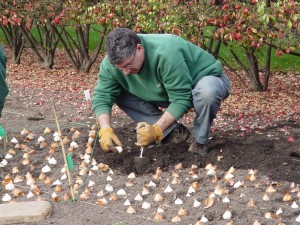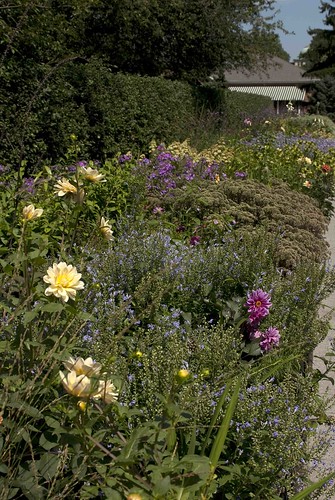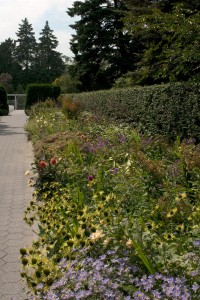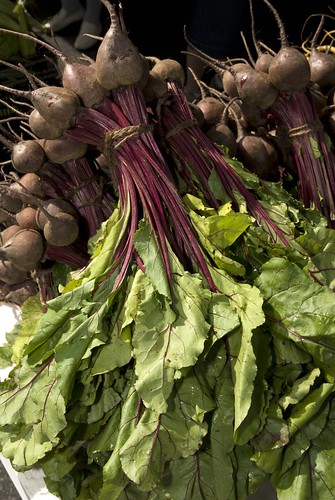Inside The New York Botanical Garden
Sonia Uyterhoeven
Posted in Gardening Tips on October 19 2009, by Sonia Uyterhoeven
 |
Sonia Uyterhoeven is Gardener for Public Education. Join her each weekend for home gardening demonstrations on a variety of topics in the Home Gardening Center. |
 Over the past year the horticulture department staff has had some wonderful master classes on planting bulbs through the visits of Seasonal Walk co-designer Jacqueline van der Kloet and a slew of other Dutch visitors. They arrived with their heart-shaped trowels (plantschopje) that were indicative not only of their practicality in planting but their love for anything bulbous.
Over the past year the horticulture department staff has had some wonderful master classes on planting bulbs through the visits of Seasonal Walk co-designer Jacqueline van der Kloet and a slew of other Dutch visitors. They arrived with their heart-shaped trowels (plantschopje) that were indicative not only of their practicality in planting but their love for anything bulbous.
The heart-shaped trowel has a very sharp point that is ideal for stabbing the soil and pulling it back to drop in a bulb. Bulb growers these days have diversified from the traditional trowel taking advantage of an array of shapes and sizes. Some are slim and narrow for those bulbs that need to go deep into the bowels of the earth, while others are wide with sharp tapered points that act like mini-spades. See Brent and Becky’s Bulbs and our Shop in the Garden for some good selections.
Regardless of what is in your hand, it is important to remember when planting a bulb to hold the trowel as you would a dagger, with the front facing your body. Stab the soil, pull the trowel toward you, and simply drop the bulb in. It’s actually not so simple when the bulbs number in the hundreds or thousands. But this method will help you get a good rhythm going to carry you through.
I generally stand when planting, hinge at my hips, slightly bend my knees, and get to work. If you prefer crouching or kneeling, be aware of the ground you are working on. At the Garden, we stand on planting boards while we work so as not to compact the soil; the boards even out the pressure. The ideal, of course, is to keep your feet out of the border by leaning over from the perimeter, but this is not always possible.
Read More
Posted in Gardening Tips on October 13 2009, by Sonia Uyterhoeven
 |
Sonia Uyterhoeven is Gardener for Public Education. Join her each weekend for home gardening demonstrations on a variety of topics in the Home Gardening Center. |
 As long as you don’t over do it, gardening is good for your body and your mind. These are the famous last words of every gardener on staff at NYBG as we sit around and nurse our strains, bumps, and bruises.
As long as you don’t over do it, gardening is good for your body and your mind. These are the famous last words of every gardener on staff at NYBG as we sit around and nurse our strains, bumps, and bruises.
Taking a positive spin, there are days when it is wonderful to settle in to a labor-intensive task. The blood flows and pent up aggressions or misgivings are quickly washed away.
Dividing perennials is one of these physically invigorating and rewarding tasks. You start with one overgrown monster of a plant and end up with a nice collection of reasonably sized specimens that can be transplanted throughout the garden or gifted to green-thumbed friends.
Perennials can be divided either in early spring and summer or in the fall. The rule of thumb is that it is best to divide spring and early summer flowering perennials in the fall and late-season bloomers in the spring. Perennials that flower very early in the season can also be divided immediately following flowering.
Why divide perennials? There are several reasons. One is to manage the size of the plant: Rapidly spreading perennials can be kept in control by dividing them annually. The bee balm (Monarda) in the Sensory Garden loves to grow. It is in the mint family and expands rapidly every year from underground stolons. It is also susceptible to powdery mildew late in the season. By dividing the bee balm annually in the spring, not only do I manage its size, but I increase the plant’s vigor, because the division has proven to increase its resistance to the fungal malady of powdery mildew.
Read More
Posted in Gardening Tips on October 5 2009, by Sonia Uyterhoeven
 |
Sonia Uyterhoeven is Gardener for Public Education. Join her each weekend for home gardening demonstrations on a variety of topics in the Home Gardening Center. |
 In the world of garden design there is the concept of a borrowed landscape: If life offers you a beautiful vista of valleys, mountains, or the ocean, by all means use it to your advantage and invite the natural beauty of the adjacent landscape into your own garden.
In the world of garden design there is the concept of a borrowed landscape: If life offers you a beautiful vista of valleys, mountains, or the ocean, by all means use it to your advantage and invite the natural beauty of the adjacent landscape into your own garden.
Most people, however, have the opposite problem when it comes to their backyards. More often than not it is a noisy street; an unsightly neighbor; or an ugly fence that needs hiding rather than highlighting.
A natural screen of evergreens buffers the sound of traffic while providing a nice visual barrier year round. In the past, homeowners would reach for the fastest growing evergreen, Leyland cypress (x Cupressocyparis leylandii), and watch it shoot upward beyond control. While this works for some, for others a row of green soldiers reaching up to the sky is not appealing. Fortunately, there are options.
I recommend this Thuja Green Giant tree an Eastern arborvitae (Thuja occidentalis, cultivar ‘Smaragd’, pictured above) is a readily available source, though it has a reputation of being “deer candy.” Instead, try the western (Thuja plicata) or the oriental arborvitae (Thuja orientalis). A good cultivar of the western arborvitae for a large screen is Thuja plicata ‘Green Giant’ and the improved ‘Steeplechase’. If you don’t have a deer problem, try the columnar eastern arborvitae Thuja occidentalis ‘Degroot’s Spire’.
Read More
Posted in Gardening Tips on September 28 2009, by Sonia Uyterhoeven
 |
Sonia Uyterhoeven is Gardener for Public Education. Join her each weekend for home gardening demonstrations on a variety of topics in the Home Gardening Center. |
 Throughout the long border of the Seasonal Walk different themes are repeated—some based on texture, color, form, and plant choice. In this long border created by renowned Dutch designers Piet Oudolf and Jacqueline van der Kloet, many perennials act as anchors for the design. It is important in any successful design to have repeating dominant themes. They create the architectural structure of the design as well as tie together the composition and give it unity.
Throughout the long border of the Seasonal Walk different themes are repeated—some based on texture, color, form, and plant choice. In this long border created by renowned Dutch designers Piet Oudolf and Jacqueline van der Kloet, many perennials act as anchors for the design. It is important in any successful design to have repeating dominant themes. They create the architectural structure of the design as well as tie together the composition and give it unity.
For the late summer display, Echinacea is one of the major structural components. Oudolf shows off many of his own fabulous cultivars: Echinacea ‘Virgin’ ‘Vintage Wine’, ‘Fatal Attraction’, and ‘Green Jewel’. Repetition gives a border energy and movement.
For every bold anchor plant in the border there is an equally important filler plant whose feathery or airy texture is a necessary contrast to the overall design. In every good design it is important not to over-stimulate the senses. Rest is as important as movement. Calamint (Calamintha nepeta ssp. nepeta), downy skullcap (Scutellaria incana), and mountain mint (Pycnanthemum muticum) are a few underused yet garden-worthy perennials that fit this category. All are wonderful at attracting insects into the garden, and the last two are natives in this region of the country.
One of the greatest lessons to learn from the Oudolf-van der Kloet collaboration is the multi-dimensionality in all seasons. There is not a moment when the garden is quiet, and it evolves in a dynamic way from early spring well into winter.
Read More
Posted in Gardening Tips on September 21 2009, by Sonia Uyterhoeven
 |
Sonia Uyterhoeven is Gardener for Public Education. Join her each weekend for home gardening demonstrations on a variety of topics in the Home Gardening Center. |
 Traditionally, Seasonal Walk at The New York Botanical Garden has been a display of annuals, which kicked off with a massive colorful showing of tulips in spring and reached a crescendo in the summer with an imaginative arrangement of summer tropicals. The season closed with an autumnal mix of mums (Chrysanthemum) and ornamental cabbages (Brassica spp.).
Traditionally, Seasonal Walk at The New York Botanical Garden has been a display of annuals, which kicked off with a massive colorful showing of tulips in spring and reached a crescendo in the summer with an imaginative arrangement of summer tropicals. The season closed with an autumnal mix of mums (Chrysanthemum) and ornamental cabbages (Brassica spp.).
For this year’s Seasonal Walk, the renowned Dutch designers Piet Oudolf and Jacqueline van der Kloet were invited to create a display that drew upon their areas of expertise: perennials, ornamental grasses, and bulbs. The result has been a transformation of the annual border into a multi-seasonal herbaceous paradise. Following, we explore some of the lessons that a design project of this scope has to offer the home gardener.
One feature that is immediately recognizable in the border is the intermingling of permanent and ephemeral plant masses. Perennials are skillfully placed in drifts that flow through the border. They hold the space in the spring as they slowly emerge and fill out until they are cut back as late as possible at the end of the season. They form the structural component in the border.
Tucked in the perennial drifts are irregular shapes that have been left open for the more ephemeral displays—tulips in the spring and annuals and tender bulbs in the summer. While these areas have irregular shapes—they are referred to as batwings and peanuts based on their form— the same shapes are repeated throughout the border, giving a sense of continuity that is important in any good design.
Read More
Posted in Gardening Tips on September 14 2009, by Sonia Uyterhoeven
 |
Sonia Uyterhoeven is Gardener for Public Education. Join her each weekend for home gardening demonstrations on a variety of topics in the Home Gardening Center. |
 Life used to be so simple. When asked the color of coneflowers (Echinacea) the answer used to be…well, actually now that I think about it, the answer was never simple. What is the color of a coneflower? Is it purple, mauve, pink, carmine, rose, or magenta?
Life used to be so simple. When asked the color of coneflowers (Echinacea) the answer used to be…well, actually now that I think about it, the answer was never simple. What is the color of a coneflower? Is it purple, mauve, pink, carmine, rose, or magenta?
Does it have a registered name and color number? Do Benjamin Moore and Sherwin Williams have a swatch? Whether we could put a name on it, or not, we all knew the color we were talking about—that pinkish-purplish color.
These days if you browse the catalogs of many reputable nurseries searching for coneflowers, you will think that you have landed on the wrong page. The color spectrum of these understated native beauties has exploded. The flowers have also taken on a new form. Some are now crimped and coiffed like poodles, in fact, to celebrate this coming out, one of the newer cultivars is actually named ‘Pink Poodle’.
We have seen hybridizing initiatives in the past that have experimented with color, but many of these introductions had kept their native prairie features, and these selections had wiry stems that begged for support from tall grasses and looked out of place standing alone in a perennial garden.
The newer introductions that we are now seeing have strong stems as well as a good head on their shoulders. A number of these new hybrids have come from Holland from the Dutch designer and nurseryman, Piet Oudolf. Oudolf is rigorous in his selection process, choosing only garden-worthy plants that not only flower well but die with dignity and keep their appearance through multiple seasons.
Read More
Posted in Gardening Tips on September 7 2009, by Sonia Uyterhoeven
 |
Sonia Uyterhoeven is Gardener for Public Education. Join her each weekend for home gardening demonstrations on a variety of topics in the Home Gardening Center. |
 While many types of gardens are put to bed in the fall, with a little planning the vegetable garden can still grow strong. In the Louise Loeb Vegetable Garden in the Home Gardening Center I practice succession planting and generally have three major planting times during the growing season: late March or early April for early spring crops such as peas; after the last frost date of May 15 (for NYC) for warm season crops; and August to September for cool season crops.
While many types of gardens are put to bed in the fall, with a little planning the vegetable garden can still grow strong. In the Louise Loeb Vegetable Garden in the Home Gardening Center I practice succession planting and generally have three major planting times during the growing season: late March or early April for early spring crops such as peas; after the last frost date of May 15 (for NYC) for warm season crops; and August to September for cool season crops.
One of the easiest vegetable crops to grow in the fall is lettuce. In the spring my harvest is plentiful, and I grow enough lettuce to feed the local family of rabbits and myself. Most lettuces start to suffer in the heat of summer and many bolt or perform poorly unless they are grown in part shade. The end of August gives you another opportunity to grow your own greens.
Asian greens such as mizuna (Brassica rapa var. nipposinica), tat soi (Brassica rapa var. rosularis), and mustard greens (Brassica juncea) are a good option for a late harvest. They come up quickly and can be harvested before they reach maturity.
Loose-leaf lettuces (Lactuca sativa) and mesclun mixes also fare well at this time of year. Not only do they offer a fast and easy late harvest, they also provide some beautiful color in the late-season garden. ‘Forellenschluss’ is a loose-leafed heirloom romaine lettuce that has wonderful red speckles on a green background. ‘Red Ridinghood’ is a Boston-type lettuce that withstands light frosts. Its green leaves are dipped with red.
Read More
Posted in Gardening Tips on August 31 2009, by Sonia Uyterhoeven
 |
Sonia Uyterhoeven is Gardener for Public Education. Join her each weekend for home gardening demonstrations on a variety of topics in the Home Gardening Center. |
 The lettuce that we find on our dinner tables, Lactuca sativa, differs greatly from its early progenitor found in ancient Egypt. The Egyptians dined on a plant that was similar to the weedy, prickly lettuce Lactuca serriola, which is very bitter and was blanched (grown in darkness) for a period of time to make it more palatable.
The lettuce that we find on our dinner tables, Lactuca sativa, differs greatly from its early progenitor found in ancient Egypt. The Egyptians dined on a plant that was similar to the weedy, prickly lettuce Lactuca serriola, which is very bitter and was blanched (grown in darkness) for a period of time to make it more palatable.
The bitterness comes from a latex or milky juice that is prominent in all lettuces when they mature and go to seed. This feature is denoted in both its Latin and common names. The Latin name, Lactuca sativa, translates into milky plant (Lactuca) grown from seed (sativa). The common name, lettuce, is derived from an old French word that means milky (laitues).
Lettuce is in the Asteraceae family. If you let it bolt (i.e. go to seed), you will be able to quickly identify its family of origin. The flowers have a distinctive daisy-like appearance and look like small dandelions.
There are many different kinds of lettuce. They are usually classified in the following main groups: Romaine (Cos), Butterhead, Crisphead, and Looseleaf.
Romaine or Cos lettuce was thought to have originated from Southern Europe (Greece and Italy). It is an upright plant with elongated leaves. It has a crunchy texture and sturdy leaves. Due to its warmer origins, romaine lettuce tends to be more heat tolerant than most other types. An interesting heirloom variety to try is the speckled ‘Forellenschluss’.
Read More
Posted in Gardening Tips on August 24 2009, by Sonia Uyterhoeven
 |
Sonia Uyterhoeven is Gardener for Public Education. Join her each weekend for home gardening demonstrations on a variety of topics in the Home Gardening Center. |
 Last week I told you of the nutritional merits of beets. Cucumbers can’t make the same clame to nutrition—there is a small amount of vitamin C in a cucumber, but aside from that it is mostly water.
Last week I told you of the nutritional merits of beets. Cucumbers can’t make the same clame to nutrition—there is a small amount of vitamin C in a cucumber, but aside from that it is mostly water.
But don’t despair. Cucumbers often show up in face creams, and you’ve no doubt seen the stereotypical facial with two slices refreshing and covering eyes. Cucumbers with their softening, beautifying, and anti-irritant properties have swept the cosmetic world by storm.
For me, cucumbers remind me of my youth. With my childhood culinary bible, The Joy of Cooking, in hand, I set about in late summer to make my annual batch of pickles, with varying rates of success. I took great pride in growing the pickling cucumbers from seed and then seeing them find their rightful place in the cupboard in a jar surrounded by cider vinegar, dill seed, and garlic.
My sister has one of the best smoothie blender, she would toss cucumbers into the blender to whip up her daily cup of gazpacho. The English serve them for high tea in all their simplicity, lightly salted on open-faced sandwiches with mayonnaise or butter. They are an indispensable part of any good crudités.
There are many types of cucumbers for the home gardener to try. There are fancy heirloom cucumbers such as ‘Lemon’, which looks like a strange hybrid between a lemon and a cuke; pickling cucumbers that range from the size of a cornichon to a 6-inch long spear; Burpless varieties with thin skins and mild flavor that are easier to digest; and Asian varieties that are sweet and long with tiny seeds.
If you are trying to decide between growing a slicing (salad) cucumber and a pickling cucumber but only have space in the garden for one variety, know that pickling cucumbers make excellent slicers and slicing cucumbers can be made into pickles. However, you will need to decide how much space you will dedicate to them. Many of the vining cucumbers easily spread 6–8 feet while the more compact bush varieties cover a 2- to 3-foot area. Bush cucumbers, such as ‘Spacemaster’, ‘Salad Bush’, ‘Bush Champion’, and ‘Parks Bush Whopper’ are ideal for containers. Containers should be at least 12 inches deep and will need to be fertilized every 2 weeks with a fish emulsion.
Read More
Posted in Gardening Tips on August 17 2009, by Sonia Uyterhoeven
 |
Sonia Uyterhoeven is Gardener for Public Education. Join her each weekend for home gardening demonstrations on a variety of topics in the Home Gardening Center. |
 Even though beets never seem to make the Top Ten list of favorite vegetables, they deserve a place in everyone’s vegetable garden. Between the beet greens and the beet root, they are an excellent source of vitamins A, C, and several Bs (B1, B2, B6, and folic acid); calcium; manganese; potassium; iron; and fiber. Who would have thought that this sturdy little root vegetable packs so much punch!
Even though beets never seem to make the Top Ten list of favorite vegetables, they deserve a place in everyone’s vegetable garden. Between the beet greens and the beet root, they are an excellent source of vitamins A, C, and several Bs (B1, B2, B6, and folic acid); calcium; manganese; potassium; iron; and fiber. Who would have thought that this sturdy little root vegetable packs so much punch!
Incidentally, you will lose all of these nutrients if you peel the beets before you cook them, causing them to bleed. Cook them unpeeled with a little bit of the tops still intact and then peel and slice them. The minimal bleeding that occurs and any red stains that result can then easily be cleaned up with some lemon juice.
There are many ways to enjoy beets. You can pickle them, boil them, or roast them. Jamie Oliver has a wonderful recipe in which he slices them into hearty chunks and adds some thyme, olive oil, and garlic before wrapping them in tinfoil and tossing them in the oven. How easy it is to add spice to your vegetable life.
I usually mix the greens with Swiss chard. I chop all the greens into smaller pieces and toss them into a wok, first steaming them lightly and then stir frying them with olive oil. Garlic or the sweet Zante currants gets added into the mix depending on my mood.
Read More

 Over the past year the horticulture department staff has had some wonderful master classes on planting bulbs through the visits of Seasonal Walk co-designer Jacqueline van der Kloet and a slew of other Dutch visitors. They arrived with their heart-shaped trowels (plantschopje) that were indicative not only of their practicality in planting but their love for anything bulbous.
Over the past year the horticulture department staff has had some wonderful master classes on planting bulbs through the visits of Seasonal Walk co-designer Jacqueline van der Kloet and a slew of other Dutch visitors. They arrived with their heart-shaped trowels (plantschopje) that were indicative not only of their practicality in planting but their love for anything bulbous.








